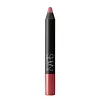What's inside
What's inside
 Key Ingredients
Key Ingredients

 Benefits
Benefits

 Concerns
Concerns

 Ingredients Side-by-side
Ingredients Side-by-side

Cyclopentasiloxane
EmollientDimethicone
EmollientPolyethylene
AbrasiveSynthetic Fluorphlogopite
Sucrose Acetate Isobutyrate
Trimethylsiloxysilicate
EmollientPolypropylsilsesquioxane
C30-50 Alcohols
EmulsifyingPolybutene
Polymethylsilsesquioxane
Triethoxycaprylylsilane
Aloe Barbadensis Leaf Extract
EmollientBis-Hydroxyethoxypropyl Dimethicone
EmollientCetyl PEG/PPG-10/1 Dimethicone
EmulsifyingTocopheryl Acetate
AntioxidantDimethicone Crosspolymer
Emulsion StabilisingDimethicone/Vinyl Dimethicone Crosspolymer
Skin ConditioningPentaerythrityl Tetraethylhexanoate
EmollientBHT
AntioxidantBenzoic Acid
MaskingCI 77891
Cosmetic ColorantCI 45410
Cosmetic ColorantMica
Cosmetic ColorantIron Oxides
CI 15850
Cosmetic ColorantCI 19140
Cosmetic ColorantCI 42090
Cosmetic ColorantCyclopentasiloxane, Dimethicone, Polyethylene, Synthetic Fluorphlogopite, Sucrose Acetate Isobutyrate, Trimethylsiloxysilicate, Polypropylsilsesquioxane, C30-50 Alcohols, Polybutene, Polymethylsilsesquioxane, Triethoxycaprylylsilane, Aloe Barbadensis Leaf Extract, Bis-Hydroxyethoxypropyl Dimethicone, Cetyl PEG/PPG-10/1 Dimethicone, Tocopheryl Acetate, Dimethicone Crosspolymer, Dimethicone/Vinyl Dimethicone Crosspolymer, Pentaerythrityl Tetraethylhexanoate, BHT, Benzoic Acid, CI 77891, CI 45410, Mica, Iron Oxides, CI 15850, CI 19140, CI 42090
C12-13 Alkyl Ethylhexanoate
EmollientSynthetic Candelilla Wax
EmollientPolyethylene
AbrasiveCaprylyl Methicone
Skin ConditioningCyclopentasiloxane
EmollientSilica
AbrasiveDimethicone
EmollientSucrose Acetate Isobutyrate
Hydrogenated Coco-Glycerides
EmollientDisteardimonium Hectorite
StabilisingPropylene Carbonate
SolventLecithin
EmollientMethylparaben
PreservativePropylparaben
PreservativeAroma
Tocopherol
AntioxidantAscorbyl Palmitate
AntioxidantDicalcium Phosphate
AbrasiveCitric Acid
BufferingBHT
AntioxidantAnise Alcohol
PerfumingMica
Cosmetic ColorantCI 77891
Cosmetic ColorantCI 77491
Cosmetic ColorantCI 77492
Cosmetic ColorantCI 77499
Cosmetic ColorantCI 15850
Cosmetic ColorantCI 19140
Cosmetic ColorantC12-13 Alkyl Ethylhexanoate, Synthetic Candelilla Wax, Polyethylene, Caprylyl Methicone, Cyclopentasiloxane, Silica, Dimethicone, Sucrose Acetate Isobutyrate, Hydrogenated Coco-Glycerides, Disteardimonium Hectorite, Propylene Carbonate, Lecithin, Methylparaben, Propylparaben, Aroma, Tocopherol, Ascorbyl Palmitate, Dicalcium Phosphate, Citric Acid, BHT, Anise Alcohol, Mica, CI 77891, CI 77491, CI 77492, CI 77499, CI 15850, CI 19140
 Reviews
Reviews

Ingredients Explained
These ingredients are found in both products.
Ingredients higher up in an ingredient list are typically present in a larger amount.
BHT is a synthetic antioxidant and preservative.
As an antioxidant, it helps your body fight off free-radicals. Free-radicals are molecules that may damage your skin cells.
As a preservative, it is used to stabilize products and prevent them from degrading. Specifically, BHT prevents degradation from oxidation.
The concerns related to BHT come from oral studies; this ingredient is currently allowed for use by both the FDA and EU.
However, it was recently restricted for use in the UK as of April 2024.
Learn more about BHTCi 15850 is the pigment color red. It is an azo dye and created synthetically.
Azo dyes need to be thoroughly purified before use. This allows them to be more stable and longer-lasting.
This ingredient is common in foundations, lipsticks, and blushes. This color is described as brown/orangey red.
It has many secondary names such as Red 6 and Red 7. According to a manufacturer, Red 6 usually contains aluminum.
Learn more about CI 15850CI 19140 is also known as Tartrazine. Tartrazine is a synthetic dye used in cosmetics, foods, and medicine to add a yellow color.
Tartrazine is created from petroleum and is water-soluble.
Some people may experience allergies from this dye, especially asthmatics and those with an aspirin intolerance.
Learn more about CI 19140Ci 77891 is a white pigment from Titanium dioxide. It is naturally found in minerals such as rutile and ilmenite.
It's main function is to add a white color to cosmetics. It can also be mixed with other colors to create different shades.
Ci 77891 is commonly found in sunscreens due to its ability to block UV rays.
Learn more about CI 77891Cyclopentasiloxane, or D5, is a silicone used to improve texture of products and trap moisture.
D5 is considered lightweight and volatile. Volatile means it evaporates quickly after application. Once evaporated, D5 leaves a thin barrier that helps keep skin hydrated.
It is also an emollient. Emollients help soften the skin and prevent water loss. Silicones create a silky texture in products. D5 helps other ingredients become more spreadable.
Studies show D5 is safe to use in skincare products. We recommend speaking with a skincare professional if you have concerns.
Learn more about CyclopentasiloxaneDimethicone is a type of synthetic silicone created from natural materials such as quartz.
What it does:
Dimethicone comes in different viscosities:
Depending on the viscosity, dimethicone has different properties.
Ingredients lists don't always show which type is used, so we recommend reaching out to the brand if you have questions about the viscosity.
This ingredient is unlikely to cause irritation because it does not get absorbed into skin. However, people with silicone allergies should be careful about using this ingredient.
Note: Dimethicone may contribute to pilling. This is because it is not oil or water soluble, so pilling may occur when layered with products. When mixed with heavy oils in a formula, the outcome is also quite greasy.
Learn more about DimethiconeMica is a naturally occurring mineral used to add shimmer and color in cosmetics. It can also help improve the texture of a product or give it an opaque, white/silver color.
Serecite is the name for very fine but ragged grains of mica.
This ingredient is often coated with metal oxides like titanium dioxide. Trace amounts of heavy metals may be found in mica, but these metals are not harmful in our personal products.
Mica has been used since prehistoric times throughout the world. Ancient Egyptian, Indian, Greek, Roman, Aztec, and Chinese civilizations have used mica.
Learn more about MicaPolyethylene is a synthetic ingredient that helps the skin retain moisture. It is a polymer.
It is also typically used within product formulations to help bind solid ingredients together and thicken oil-based ingredients. When added to balms and emulsions, it helps increase the melting point temperature.
We don't have a description for Sucrose Acetate Isobutyrate yet.